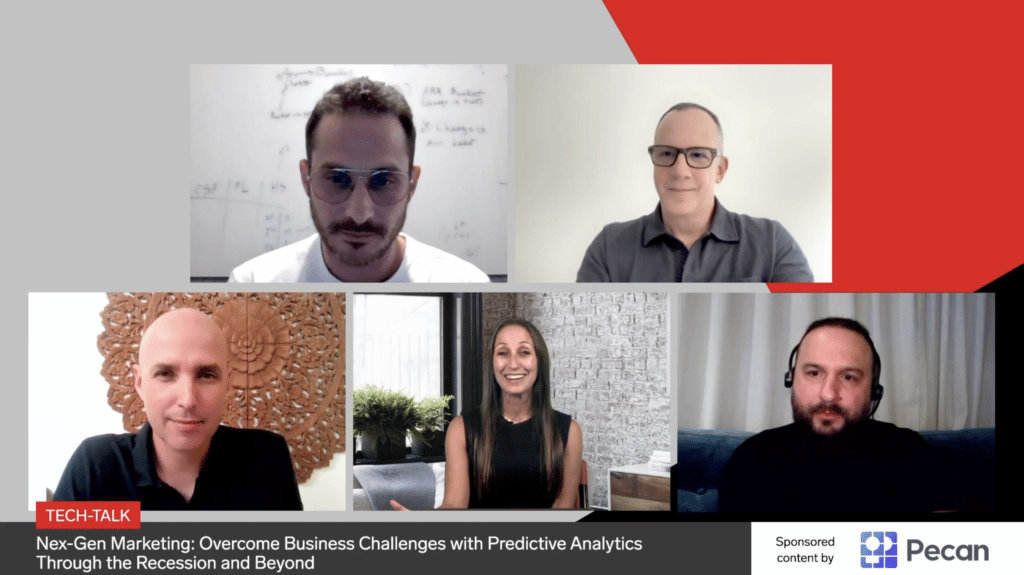In a recession or other uncertain business conditions, marketers are often called upon to justify spending and ensure resources are used to their fullest potential. This balancing act is even harder as third-party customer data becomes more opaque, and customer behaviors change rapidly. AI in marketing is becoming an increasingly widespread solution to these challenges.
Last week, we sat down for a fascinating, global panel discussion of B2B and B2C marketing veterans. They talked about how future-driven planning, aided by advanced analytics, can inform proactive strategies. Moderated by our CEO and co-founder Zohar Bronfman, we had a spirited conversation with Yanay Sela, CMO of Bright Data; Moshi Blum, CMO of Beach Bum; and Andrew Essex, CEO of GoingConcern and Mobile Marketing Association board member.
Evolve your approach to data and measurement
Every business wants to understand where customers are coming from so they can optimize their marketing and advertising strategy. Unquestionably, that optimization has to happen in an increasingly complex marketplace. Now that consumers have more choices than ever, behavior is less predictable. Furthermore, privacy regulations are making it more difficult to track the customer journey.
“Once upon a time in marketing, there was an old line that said 50% of the spend worked. We just didn’t know what spend worked,” Andrew Essex says. “Obviously, we’ve come a long way now, and multi-touch attribution is getting very complicated. And as it matures, there’s a paradox happening. As it gets more and more complicated, it then gets more and more confusing. So in some respects, we’re back to where we started. I’m finding a lot of people just don’t know how to reconcile results.”
To emphasize that point: Many marketing and business leaders agree with Andrew. MediaPost reported that in a survey of 300 CMOs, finding “systems that connect data silos and boost accessibility” is the No. 1 barrier to effective use of data, named by 64%. Adequate talent and budget are tied for the next most significant problem, at 58%.
Left to right: Moshi Blum, Zohar Bronfman, Marissa Coslov, Andrew Essex, Yanay Sela
Of course, we all know that the world’s data is growing at an accelerated rate. So how can business line leaders take control over their own data? In this situation, automation is increasingly critical.
“Automation becomes very important because otherwise, you have to build everything repeatedly,” notes Zohar. “You find yourself with a project that will end 12 months from now. In the meantime, the entire customer behavioral pattern changes within a week.”
Maintaining agility and alignment with AI in marketing
To remain agile in a wide range of potential economic scenarios, marketers undoubtedly need to integrate their data and reporting via automated workflows. This approach will provide visibility into the drivers of core KPIs. In addition, it offers detailed, nuanced insights that can be shared with ad platforms for optimization.
“There’s a lot of haystack and very little needle out there. Predictive analytics is the solution that my clients are looking for because it gets you to that elusive, almost mythical one-to-one relationship. You can then truly quantify value and develop proof cases for intelligent marketing,” Andrew says.
Yanay Sela expressed a similar sentiment. In view of these advantages, Yanay has certainly found it easier to get colleagues, the C-suite, and the board aligned with predictive analytics in marketing.
“Predictive analytics eliminates the need to go back and look at the legs we’re building our strategy on,” Yanay says. “The conversation becomes a lot more concrete and specific. We’re able to all look at things from the same prism.”
With the results of predictive modeling in hand, Yanay has found it easier to get colleagues, the C-suite, and the board aligned.
Winning strategies need data – and insights from predictive analytics in marketing
Last year, 38% of B2C marketing decision-makers said they’ll “focus on the implementation of new systems and technologies to support their organization’s business strategy” over the next two years, according to a Forrester survey. In fact, the company’s analysts note that “technology becomes even more important when you need to measure how marketing drives business value and distribute insights across the entire organization.”
Predictive analytics in marketing can help brands gain valuable insights to markedly increase effectiveness. You can then address questions such as: Who are your high-value customers? What are the best ways to engage them? How do you prevent them from leaving?
At the same time, Facebook or Google advertisers are keenly aware of increasing challenges with cost effectiveness and difficulty with targeting. That’s partly due to the drastic loss of marketing signals after the introduction of iOS 14.5. However, Pecan’s mobile customers have used predictive analytics in marketing, plus their existing first-party data, to overcome these limitations.
“We have started to work with Pecan in the last six months and have already developed a user acquisition model that has shown a very good initial result for two of our games,” notes Moshi Blum.
With consumer behavior becoming more erratic in difficult economic circumstances, predictive analytics in marketing has multiple purposes. For example, it can help you forecast potential outcomes, identify high-value users early, and build personalized campaigns that generate increased marketing ROI.
Marketers can make much more proactive decisions about where to direct their spend, or what they may want to offer to a specific customer.
Know where to direct your spend with AI in marketing
Marketers in any industry must pay attention to high-value customers first and make sure they’re identifying those customers accurately. In particular, it’s inefficient to spread dollars thinly to attract just anyone to click on your ad, download your app, or make a first purchase. Instead, finding VIPs early in the customer journey can significantly improve marketing ROI and stretch your marketing program dollars further. What’s more, this targeted approach positions marketers to refocus on an improved customer journey that drives long-term, sustainable relationships with their most valuable customers.
With this information, marketers can make much more proactive decisions about where to direct their spend, or what they may want to offer to a specific customer. Then, they can design much more specific, personalized journeys.
“With my clients, I’m seeing a massive increase in ROAS with the use of predictive analytics to optimize segments, focus on moveable middles, reduce spend, or make spend more effective by sharpening it,” says Andrew.
Overall, when the economic landscape was much more stable, we may have been able to get by with generalized assumptions about customer behavior. However, today, we live in a world where that’s no longer possible. Without a doubt, the assistance of machine learning is critical to building highly refined, targeted, and proactive strategies.
“You can throw the hard questions at machine learning, or you can try to do it yourself and crash Excel,” Yanay adds.
Learn more from the full conversation on demand
Ready to learn more about answering your hardest questions with predictive analytics? Watch the full webinar to hear these leaders discuss how you can plan to thrive in a down economy.
It’s time to get proactive and predictive. Get in touch for a quick, easy use-case consultation.




